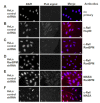Regulation of c-Raf Stability through the CTLH Complex
- PMID: 30795516
- PMCID: PMC6412545
- DOI: 10.3390/ijms20040934
Regulation of c-Raf Stability through the CTLH Complex
Abstract
c-Raf is a central component of the extracellular signal-regulated kinase (ERK) pathway which is implicated in the development of many cancer types. RanBPM (Ran-Binding Protein M) was previously shown to inhibit c-Raf expression, but how this is achieved remains unclear. RanBPM is part of a recently identified E3 ubiquitin ligase complex, the CTLH (C-terminal to LisH) complex. Here, we show that the CTLH complex regulates c-Raf expression through a control of its degradation. Several domains of RanBPM were found necessary to regulate c-Raf levels, but only the C-terminal CRA (CT11-RanBPM) domain showed direct interaction with c-Raf. c-Raf ubiquitination and degradation is promoted by the CTLH complex. Furthermore, A-Raf and B-Raf protein levels are also regulated by the CTLH complex, indicating a common regulation of Raf family members. Finally, depletion of CTLH subunits RMND5A (required for meiotic nuclear division 5A) and RanBPM resulted in enhanced proliferation and loss of RanBPM promoted tumour growth in a mouse model. This study uncovers a new mode of control of c-Raf expression through regulation of its degradation by the CTLH complex. These findings also uncover a novel target of the CTLH complex, and suggest that the CTLH complex has activities that suppress cell transformation and tumour formation.
Keywords: CTLH complex; ERK pathway; RMND5A; RanBPM; c-Raf; cancer; ubiquitination.
Conflict of interest statement
The authors declare no conflict of interest.
Figures







Similar articles
-
Inhibition of HDAC6 activity through interaction with RanBPM and its associated CTLH complex.BMC Cancer. 2017 Jul 1;17(1):460. doi: 10.1186/s12885-017-3430-2. BMC Cancer. 2017. PMID: 28668087 Free PMC article.
-
Cell signalling pathway regulation by RanBPM: molecular insights and disease implications.Open Biol. 2017 Jun;7(6):170081. doi: 10.1098/rsob.170081. Open Biol. 2017. PMID: 28659384 Free PMC article. Review.
-
Interactions of an Arabidopsis RanBPM homologue with LisH-CTLH domain proteins revealed high conservation of CTLH complexes in eukaryotes.BMC Plant Biol. 2012 Jun 7;12:83. doi: 10.1186/1471-2229-12-83. BMC Plant Biol. 2012. PMID: 22676313 Free PMC article.
-
The mammalian CTLH complex is an E3 ubiquitin ligase that targets its subunit muskelin for degradation.Sci Rep. 2019 Jul 8;9(1):9864. doi: 10.1038/s41598-019-46279-5. Sci Rep. 2019. PMID: 31285494 Free PMC article.
-
Structural and Functional Insights into GID/CTLH E3 Ligase Complexes.Int J Mol Sci. 2022 May 24;23(11):5863. doi: 10.3390/ijms23115863. Int J Mol Sci. 2022. PMID: 35682545 Free PMC article. Review.
Cited by
-
Oral cancer cell to endothelial cell communication via exosomal miR-21/RMND5A pathway.BMC Oral Health. 2024 Jan 16;24(1):82. doi: 10.1186/s12903-024-03852-3. BMC Oral Health. 2024. PMID: 38229133 Free PMC article.
-
Targeting CRAF kinase in anti-cancer therapy: progress and opportunities.Mol Cancer. 2023 Dec 18;22(1):208. doi: 10.1186/s12943-023-01903-x. Mol Cancer. 2023. PMID: 38111008 Free PMC article. Review.
-
Proteomic analysis of ubiquitination substrates reveals a CTLH E3 ligase complex-dependent regulation of glycolysis.FASEB J. 2021 Sep;35(9):e21825. doi: 10.1096/fj.202100664R. FASEB J. 2021. PMID: 34383978 Free PMC article.
-
Recognition of nonproline N-terminal residues by the Pro/N-degron pathway.Proc Natl Acad Sci U S A. 2020 Jun 23;117(25):14158-14167. doi: 10.1073/pnas.2007085117. Epub 2020 Jun 8. Proc Natl Acad Sci U S A. 2020. PMID: 32513738 Free PMC article.
-
Muskelin acts as a substrate receptor of the highly regulated Drosophila CTLH E3 ligase during the maternal-to-zygotic transition.bioRxiv [Preprint]. 2024 Jul 1:2024.06.28.601265. doi: 10.1101/2024.06.28.601265. bioRxiv. 2024. PMID: 39005399 Free PMC article. Preprint.
References
MeSH terms
Substances
Grants and funding
LinkOut - more resources
Full Text Sources
Research Materials
Miscellaneous

